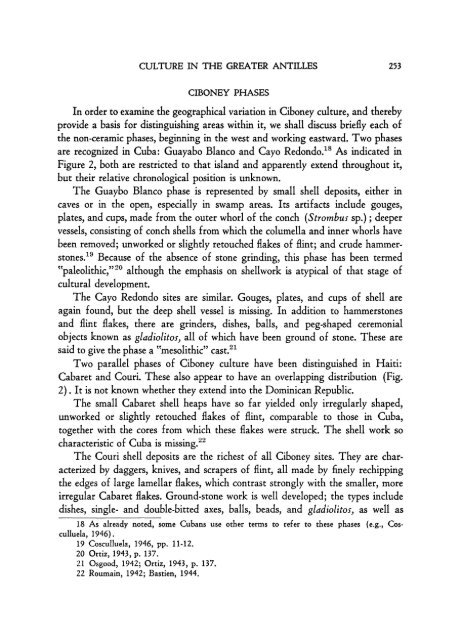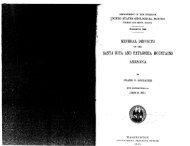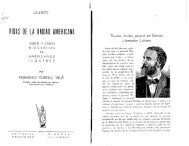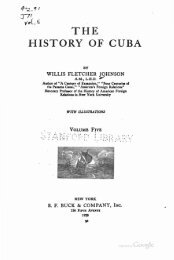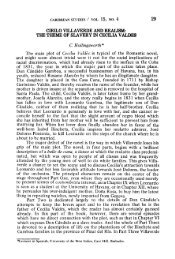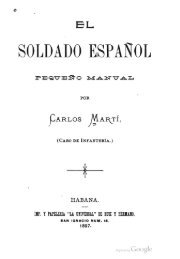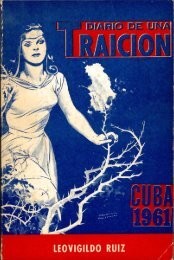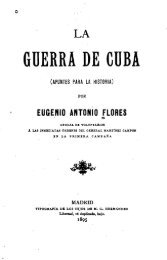Areas and Periods of Culture in the Greater Antilles
Areas and Periods of Culture in the Greater Antilles
Areas and Periods of Culture in the Greater Antilles
You also want an ePaper? Increase the reach of your titles
YUMPU automatically turns print PDFs into web optimized ePapers that Google loves.
CULTURE IN THE GREATER ANTILLES<br />
253<br />
CIBONEY PHASES<br />
In order to exam<strong>in</strong>e <strong>the</strong> geographical variation <strong>in</strong> Ciboney culture, <strong>and</strong> <strong>the</strong>reby<br />
provide a basis for dist<strong>in</strong>guish<strong>in</strong>g areas with<strong>in</strong> it, we shall discuss briefly each <strong>of</strong><br />
<strong>the</strong> non-ceramic phases, beg<strong>in</strong>n<strong>in</strong>g <strong>in</strong> <strong>the</strong> west <strong>and</strong> work<strong>in</strong>g eastward. Two phases<br />
are recognized <strong>in</strong> Cuba: Guayabo Blanco <strong>and</strong> Cayo Redondo.l8 As <strong>in</strong>dicated <strong>in</strong><br />
Figure 2, both are restricted to that isl<strong>and</strong> <strong>and</strong> apparently extend throughout it,<br />
but <strong>the</strong>ir relative chronological position is unknown.<br />
The Guaybo Blanco phase is represented by small shell deposits, ei<strong>the</strong>r <strong>in</strong><br />
caves or <strong>in</strong> <strong>the</strong> open, especially <strong>in</strong> swamp areas. Its artifacts <strong>in</strong>clude gouges,<br />
plates, <strong>and</strong> cups, made from <strong>the</strong> outer whorl <strong>of</strong> <strong>the</strong> conch (Strombus sp.); deeper<br />
vessels, consist<strong>in</strong>g <strong>of</strong> conch shells from which <strong>the</strong> columella <strong>and</strong> <strong>in</strong>ner whorls have<br />
been removed; unworked or slightly retouched flakes <strong>of</strong> fl<strong>in</strong>t; <strong>and</strong> crude hammerstones.19<br />
Because <strong>of</strong> <strong>the</strong> absence <strong>of</strong> stone gr<strong>in</strong>d<strong>in</strong>g, this phase has been termed<br />
"paleolithic,"20 although <strong>the</strong> emphasis on shellwork is atypical <strong>of</strong> that stage <strong>of</strong><br />
cultural development.<br />
The Cayo Redondo sites are similar. Gouges, plates, <strong>and</strong> cups <strong>of</strong> shell are<br />
aga<strong>in</strong> found, but <strong>the</strong> deep shell vessel is miss<strong>in</strong>g. In addition to hammerstones<br />
<strong>and</strong> fl<strong>in</strong>t flakes, <strong>the</strong>re are gr<strong>in</strong>ders, dishes, balls, <strong>and</strong> peg-shaped ceremonial<br />
objects known as gladiolitos, all <strong>of</strong> which have been ground <strong>of</strong> stone. These are<br />
said to give <strong>the</strong> phase a "mesolithic" cast.21<br />
Two parallel phases <strong>of</strong> Ciboney culture have been dist<strong>in</strong>guished <strong>in</strong> Haiti:<br />
Cabaret <strong>and</strong> Couri. These also appear to have an overlapp<strong>in</strong>g distribution (Fig.<br />
2). It is not known whe<strong>the</strong>r <strong>the</strong>y extend <strong>in</strong>to <strong>the</strong> Dom<strong>in</strong>ican Republic.<br />
The small Cabaret shell heaps have so far yielded only irregularly shaped,<br />
unworked or slightly retouched flakes <strong>of</strong> fl<strong>in</strong>t, comparable to those <strong>in</strong> Cuba,<br />
toge<strong>the</strong>r with <strong>the</strong> cores from which <strong>the</strong>se flakes were struck. The shell work so<br />
characteristic <strong>of</strong> Cuba is miss<strong>in</strong>g.22<br />
The Couri shell deposits are <strong>the</strong> richest <strong>of</strong> all Ciboney sites. They are characterized<br />
by daggers, knives, <strong>and</strong> scrapers <strong>of</strong> fl<strong>in</strong>t, all made by f<strong>in</strong>ely rechipp<strong>in</strong>g<br />
<strong>the</strong> edges <strong>of</strong> large lamellar flakes, which contrast strongly with <strong>the</strong> smaller, more<br />
irregular Cabaret flakes. Ground-stone work is well developed; <strong>the</strong> types <strong>in</strong>clude<br />
dishes, s<strong>in</strong>gle- <strong>and</strong> double-bitted axes, balls, beads, <strong>and</strong> gladiolitos, as well as<br />
18 As already noted, some Cubans use o<strong>the</strong>r terms to refer to <strong>the</strong>se phases (e.g., Cosculluela,<br />
1946).<br />
19 Cosculluela, 1946, pp. 11-12.<br />
20 Ortiz, 1943, p. 137.<br />
21 Osgood, 1942; Ortiz, 1943, p. 137.<br />
22 Rouma<strong>in</strong>, 1942; Bastien, 1944.


